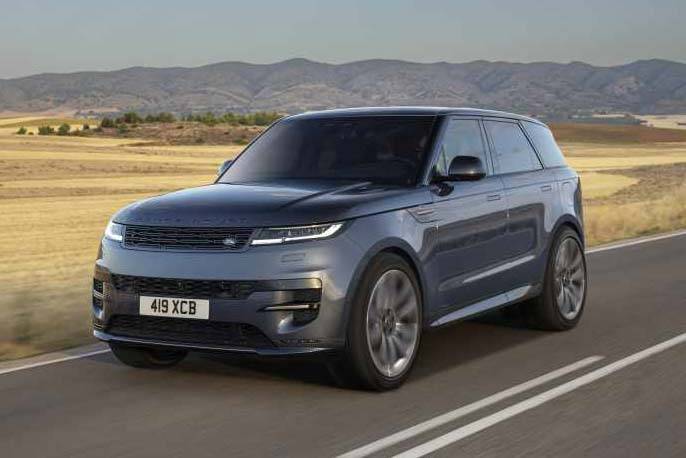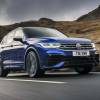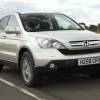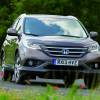
RAC sale – up to 33% off*
• Roadside cover from £5.29 a month†
• We get to most breakdowns in 60 mins or less
• Our patrols fix 4/5 breakdowns on the spot

The third generation Range Rover Sport takes a best step forward in luxury and technology. Jonathan Crouch takes a look.
Ten Second Review
The Range Rover Sport. The best of all worlds? You might think that Land Rover's flagship Range Rover model would be just about perfect if it was slightly more dynamically styled and slightly sharper to drive. That's just what the third generation Range Rover Sport aims to offer. It now feels like a six-figure SUV inside and out and there's nothing quite like it.
Background
Here's a car that claims to be able to do.... well, almost everything. It'll cruise on the autobahn at 130mph, ford rivers in the Serengeti, take a family on holiday and slip you down to the shops. It can be affordable to run, rewarding to drive and looks dynamic and stylish. There has to be a catch - doesn't there? Time to check out the third generation Range Rover Sport.
Ah yes, the Range Rover Sport. A car that in its first generation guise was neither a 'Range Rover' or 'sporty'. In fact, it was based almost entirely on the brand's sensible Discovery model and, thanks to that car's practical ladder frame chassis, as about as dynamic to drive. Still, the smarter set of clothes did the trick and for most of its life between 2005 and 2012, the MK1 'Sport' was one of Solihull's best sellers. The second generation model, launched in 2013 and updated in 2017, satisfied them far more credibly, based this time on the underpinnings of the fourth generation Range Rover. This MK4 design also shares a Range Rover chassis and powertrain, which means it's very advanced indeed.
Driving Experience
You'd expect a sharper drive than a Range Rover, but engineering almost completely shared with it - and by and large, that's what you get. Spend enough and this car can be the most dynamically able Range Rover Sport yet - we'll get to that.
A glance at the engine line-up reveals that Land Rover has no intention of abandoning diesel just yet and there are two MHEV mild hybrid options, the D300 (296bhp) and the D350 (345bhp). The rest the range is petrol-powered. The P400 (395bhp) has MHEV tech. The final option resides with a couple of Plug-in Hybrids, the P460e (460bhp) and the P550e (550bhp). These combine a 3.0-litre straight six petrol unit with a 105kW electric motor. They offer a 70 mile EAER-rated electric driving range - and if that's not enough, there's a full-EV version planned for 2024.
Whichever variant you choose, it should feel sharper to drive than the previous generation model thanks to a body structure 35% stiffer than before, offering what Land Rover claims is 'sportscar levels of stiffness'. Plus the dual chamber air suspension has been designed to limit cornering body roll - and pitch under acceleration. An optional 'Stormer' handling pack adds 'Dynamic Response Pro anti-roll control', plus rear wheel steering, torque vectoring by braking and 'Adaptive Dynamics' adaptive damping with Bilstein monotube dampers.
As before, the Range Rover Sport is unrivalled off road, with intelligently variable all-wheel drive and 'Terrain Response' with six settings. The air springs can offer a 135mm ride height increase, water up to 900mm deep can be forded and 45-degree gradients attempted.
Design and Build
You'd instantly identify this as a Range Rover Sport, though on closer inspection, this third generation model is a good deal more sophisticated to look at. It's now a fraction under five-metres long, with a silhouette featuring three defining lines. There's the roof, which slopes downwards into a bigger rear spoiler; a more angled waistline with flush fitting for the door handles and glass; and a lower line that sweeps upwards. Up-front, the grille is slimmer and the LED headlamps are the narrowest ever fitted to a Land Rover model. Out back, it's particularly striking, with a visor-like screen and tail lamps with smart red OLED embedded strips.
Inside, there's a more focused and immersive cockpit design than you'd get in a full-fat Range Rover, though all the technology is much the same. You sit 20mm lower and the steering wheel is smaller. A high centre console flows into a curved 13.1-inch central infotainment touchscreen, complemented by a 13.7-inch digital instrument binnacle. There are some lovely touches too, like the way that the speakers for the Meridian sound system can be covered with textiles.
More space for leg room has been freed up in the back thanks to a 75mm-longer wheelbase. And the cargo bay has risen in size to 835-litres - 55-litres more than before. This time round, there's no seven-seat option. And unlike the Range Rover, there's no long wheelbase version either.
Market and Model
Pricing now starts from around £84,000, which gets you base 'SE' trim with the base D300 diesel engine. Most owners will find the £3,000 premium that Land Rover wants for sportier-looking 'Dynamic SE' trim, while at the top of the liner-up, there's plush 'Autobiography'-spec. Even base 'SE' trim gets you a lot: Pixel LED headlights, 21-inch 'Style' alloy wheels, a Meridian Sound System, a fixed panoramic roof and a 3D Surround Camera system.
And that's just the start. You also get perforated Windsor leather seats with 20-way electric heated memory adjustment at the front and a heated power reclining function at the back. There's also Dynamic air suspension, 'Adaptive Dynamics' adaptive damping and the brand's unrivalled 'Terrain Response 2' set-up, which gives you various off-road driving modes. Infotainment is dealt with by a huge 13.1-inch Pivi Pro central touchscreen and there's wireless 'Apple CarPlay' and 'Android Auto' smartphone-mirroring. You also get a heated steering wheel, 2-Zone climate control, power folding mirrors and Adaptive Cruise Control with Steering Assist.
The 'Dynamic'-spec models are set apart by more unique frontal treatment and a dark grey finish for the alloy wheels. Top 'Autobiography'-spec embellishes the car with Digital LED headlights, a black contrast roof with a sliding panoramic top, 22-inch diamond turned alloy wheels, and a Head-up display. At this top level, you also get 22-way heated and ventilated massaging electric memory front seats with winged head rests. And drive dynamics are improved by all-wheel steering and an electronic active differential with torque vectoring by braking.
Cost of Ownership
The Range Rover Sport has come a long way since the days of the heavy, thirsty old first generation model. The second generation design adopted an all-aluminium body structure which cut kerb weight by a whopping 39%. This MK3 model takes another step forward with its mild hybrid tech and PHEV Plug-in powerplants. And more's to come, with a full-EV version planned in 2024.
All of these headlines rather mask the fact that the versions most customers will actually choose still lag a little behind less capable rivals when it comes to matters of efficiency. The base D300 MHEV diesel manages 37.7mpg on the combined cycle and 196g/km of CO2. For the D350 MHEV, it's 37.4mpg and 198g/km. You'll need deep pockets to run the conventional P400 petrol model, which only manages 29.9mpg and 214g/km.
Better to stretch to the P460e Plug-in Hybrid, rated at 380.6mpg and 17g/km, providing you make the most of the all-electric driving range - EAER-rated at 73 miles. Rapid charging capability of up to 50kW is included, which means an 80% charge will occupy under an hour. Use a home wallbox and a full charge will take around five hours. There's a choice of full-electric mode, plus a default Hybrid setting and a 'Save' option, which defers electric charge for when you might need it later in your trip.
Summary
With the fully fledged Range Rover being these days very much a plutocratic purchase, it's this 'Sport' model that for us, now most faithfully continues a model line stretching all the way back to the 1970 original. That very first Range Rover was a car you didn't have to be afraid to use as intended, on or off road. And nor is this one, usefully improved in this more sophisticated third generation form.
It looks and feels a more luxurious, expensive product this time round, but it's still one that wouldn't mind getting its wheels dirty, should you ever have the opportunity to exploit quite astounding reserves of off road prowess. Previous generation Range Rover Sports had to pay for that with stodgy on-road handling, but this one has improved greatly in this regard, providing you tick the right expensive options boxes. It's taken Land Rover a long time to get this model exactly right; but try it for yourself and you may well feel that it's been worth the wait.






![Jeep Cherokee [KJ] (2002-2007) used car review](https://d1ix0byejyn2u7.cloudfront.net/drive/images/made/drive/images/remote/https_d2yv47kjv2gmpz.cloudfront.net/filestore/5/0/7/1_1a7fc3f73f4a5e1/a77c0314936f46681ff5cbe676eca085/1705_41b4b9a9735aca6_100_100_70_c1_c_c.jpg)
